Sunday evening witnessed the clash between Champions League contenders Bayer Leverkusen and Eintracht Frankfurt at the BayArena. Before the match, Leverkusen placed fifth on the league table, with three points separating them from Frankfurt’s fourth spot.
The appointment of Peter Bosz in January has clearly had a big impact on how the club played this season. Compared to Heiko Herrlich’s seven wins in the first stage, Bosz helped Leverkusen secure nine wins out of 14 matches. This kept their hope of qualifying for the Champions League alive and three points would consolidate their expectation.
Frankfurt have continued their improvement throughout the season in a tremendous way. Adi Hütter’s decision to keep and elevate Niko Kovač’s tactic helped the club reach the semi-final of the Europa League. At the same time, they were on the front foot of securing the last spot to the Champions League next season but they had an awful day at the BayArena, conceding six goals and only scoring once. They were being overplayed by Leverkusen for the majority of the time and couldn’t play in the way that they wanted to.
This tactical analysis will help you understand why Leverkusen were outstanding throughout the match. We will also use statistics to analyse the factors that contributed to Frankfurt’s loss.
Lineups
Bosz lined his side up in a 4-2-3-1, with Sven Bender and Jonathan Tah playing in the central of the defence. On the right-hand side, Lars Bender came in for Mitchell Weiser. In front of them, Julian Baumgartlinger and Charles Aránguiz acted as double pivots. Up front, Bosz hoped the chemistry between Kai Havertz and Julian Brandt could help in creating chances for Lucas Alario.
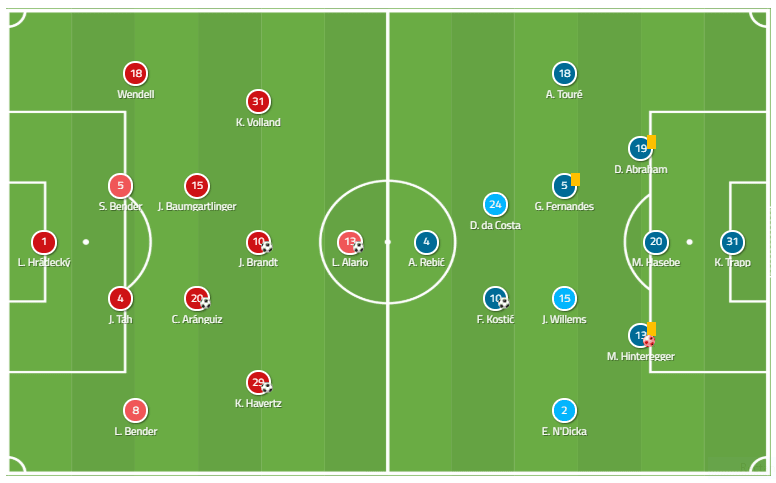
Returning from the Europa League semi-final, Hütter switched his team from a 3-5-1-1 back into a 3-4-2-1. Japanese veteran Makoto Hasebe played in the central of the defence, alongside him was David Abraham and Martin Hinteregger. Danny da Costa and Filip Kostić moved into attacking midfielder roles, right behind Ante Rebić. Rebić’s partners Luka Jović was included on the bench, while Sébastien Haller was still a doubt due to an abdominal issue.
Leverkusen’s style of play
Right at the start of the game, Leverkusen showed their intention to dominate the possession. Whenever they tried to build attacks from the back, they formed a 3-2-4-1 formation. Lars Bender usually joins up with the midfielders and his colleagues would move horizontally to form a three-man defence. Because Frankfurt usually played with a high defensive line, this helped them to overload the opposite half. At the same time, they still had five players in their own half to help with the build-up.
By utilising the passing ability of Tah and Sven Bender, they wanted to shorten the build-up time. The central defenders would play a vertical pass towards the attacking midfielder and signal their teammates to move into spaces. They also had a second choice, making a short pass towards Baumgartlinger and Aránguiz. The Chilean midfielder has the ability to dribble the ball up the pitch. He would drag along some of Frankfurt players and create spaces for his teammates to move in.
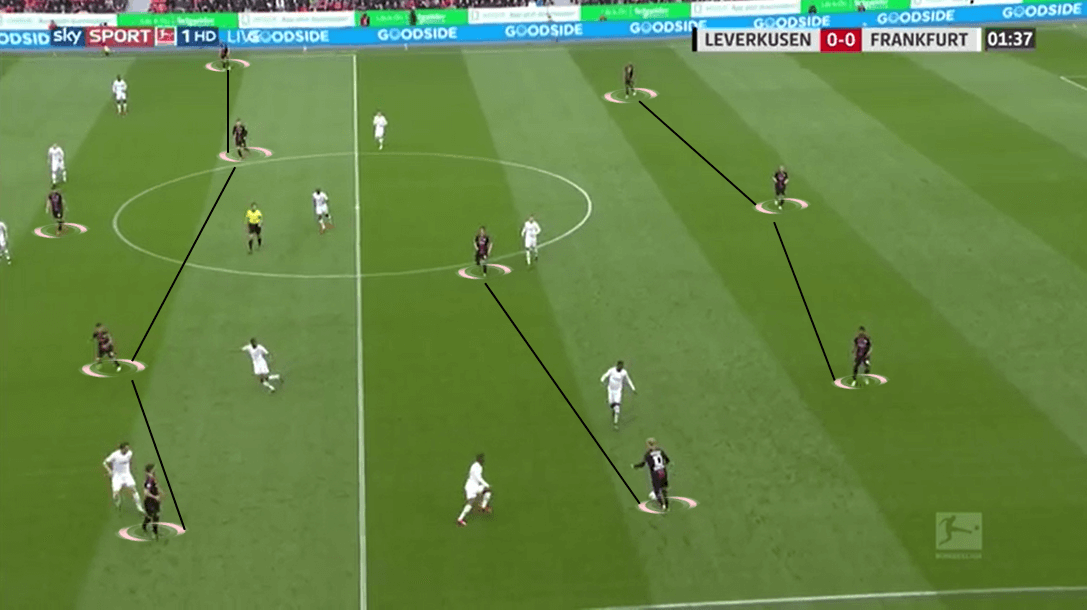
The home side favored short passes when building attacks. Although they still made 52 long passes, most of them came from the defenders when they needed to change the attacking direction. Astonishingly, they completed almost 77% of their long passes, this showed the variety of choices that Leverkusen had when they attacked. Another number that really stood out is the number of passes they made. In total, the players made 1045 passes throughout the game and completed 92.25% of them. A terrific number for a terrific side.
At the end of the game, they received what they were expected to. Leverkusen’s possession percentage never dropped below 70% and they reached that point during the middle stage of the second half. At times, their percentage went up to 80% and even 90%.
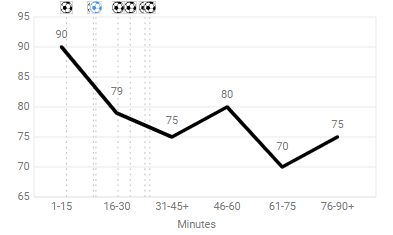
Another key factor in Bosz’s tactic is movement. Players are required to always find themselves in free space, while still being able to receive passes. That is why Leverkusen easily dominated a team that tends to play with a high defensive line like Frankfurt.
We can see how Havertz was left with a free space in the shot below. The away side’s defenders were attracted to Alario and Aránguiz’s movement, leaving Havertz free. When he received the ball from the Chilean, he had all the time in the world to place a shot.
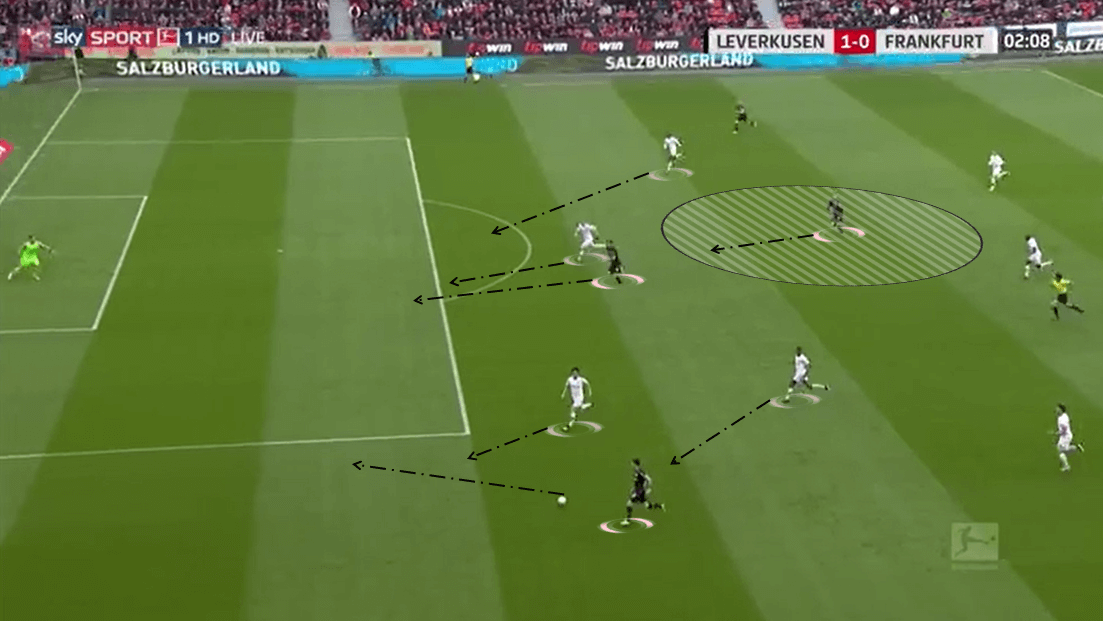
That movement has become Havertz’s signature trait throughout this season, with many of his goals coming from a similar situation. The same could be said about Brandt, though. As a dynamic midfielder, he tends to move across the pitch, creating and utilising spaces for himself and his teammates. In the first shot, we can see Brandt drop deep to fill in Aránguiz’s place and receive the ball from the defenders.
In the second shot below, we see Brandt capitalizes the space that Alario has created. The Argentinian dragged along four of Frankfurt’s defenders and opened up space for Brandt to move in. The German midfielder almost registered an assist for himself if not for Kevin Trapp’s excellence in stopping Havertz’s shot.
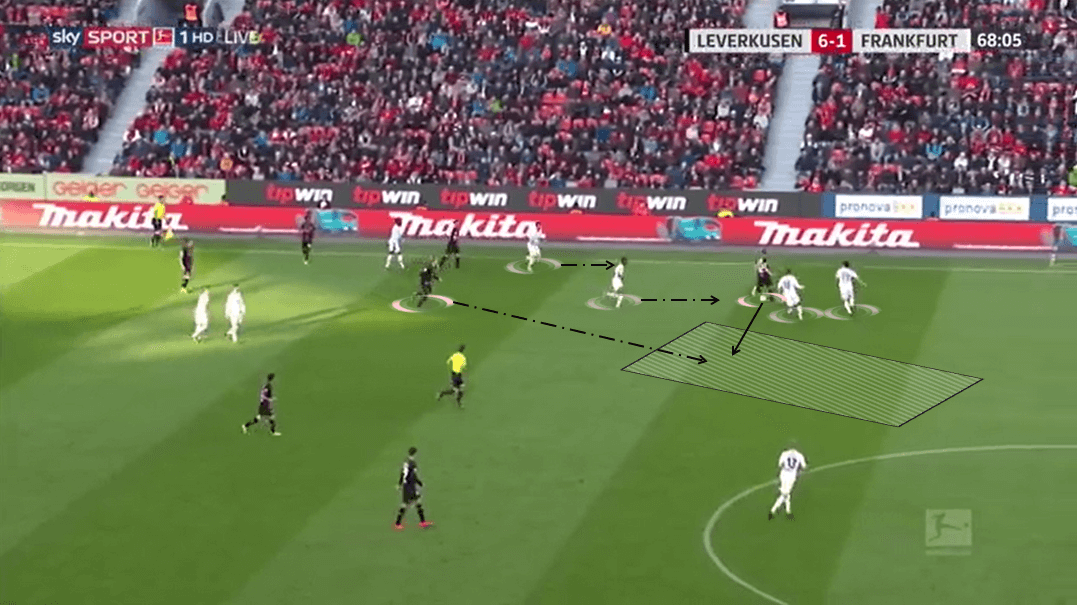
When not in possession, Leverkusen focused on pressing the opponent and preventing them from reaching Lukáš Hrádecký’s goal. On some occasions, they didn’t press high up the pitch because it might leave the defensive players vulnerable. The home side wanted to limit the number of Frankfurt’s counter-attacks through vertical passes, that’s why they formed a 4-4-1-1 defensive structure.
They pressed the opponent in the middle half, as their aim was to win the ball and start a counter-attack. Based on the numbers of successful challenges, it’s fair to say that the got what they wanted. It was also one of the factors that contributed to the domination of Leverkusen.
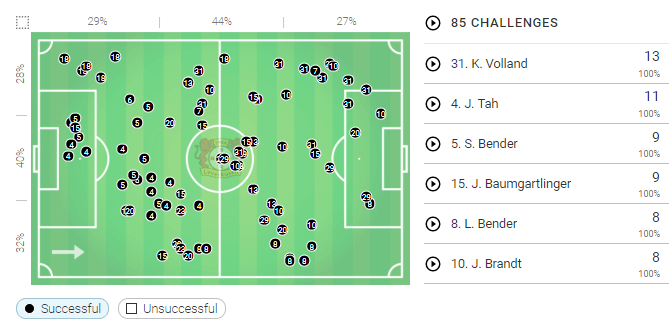
Frankfurt’s style of play
It’s fair to say that Frankfurt had a difficult day dealing with Leverkusen’s attacking force. They started off with a 3-4-2-1, with a view of turning into a 5-4-1 when out of possession. Da Costa and Kostić would join Gelson Fernandes and Jetro Willems in forming the midfield line. While former Monaco defender Almamy Touré and Evan N’Dicka also dropped deep to form the defensive line. Hütter picked many pacey players to deal with Leverkusen’s attackers, but he was forced to play them out of position.
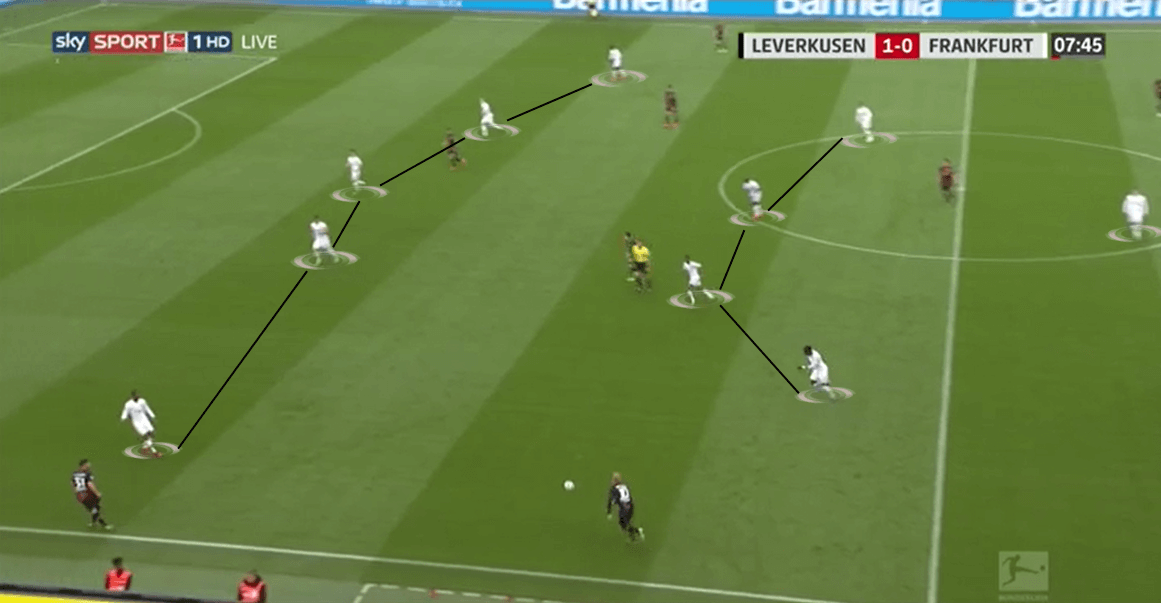
They had two problems with this system. First up, they left spaces between channels for Leverkusen players to utilise. Playing with a high defensive line was something that Frankfurt tended to do this season, but it needed the help from the press coming from the strikers, the thing which we will talk about later in the article. When Frankfurt lost possession, they didn’t have much time to recover from it and retreat their players into their half. As a result, it created spaces between the lines, allowing Leverkusen players chance to capitalize. Brandt and Havertz are players that like to play inside that space and the made Frankfurt pay on several occasions.
The second problem is Frankfurt’s press. During the first stage of the game, they pressed with five players, three strikers and two central midfielders. They also formed a pressing structure in the process, as demonstrated in the shot below. Each player was responsible for one Leverkusen player and they would close down whenever the opposition player had the ball.
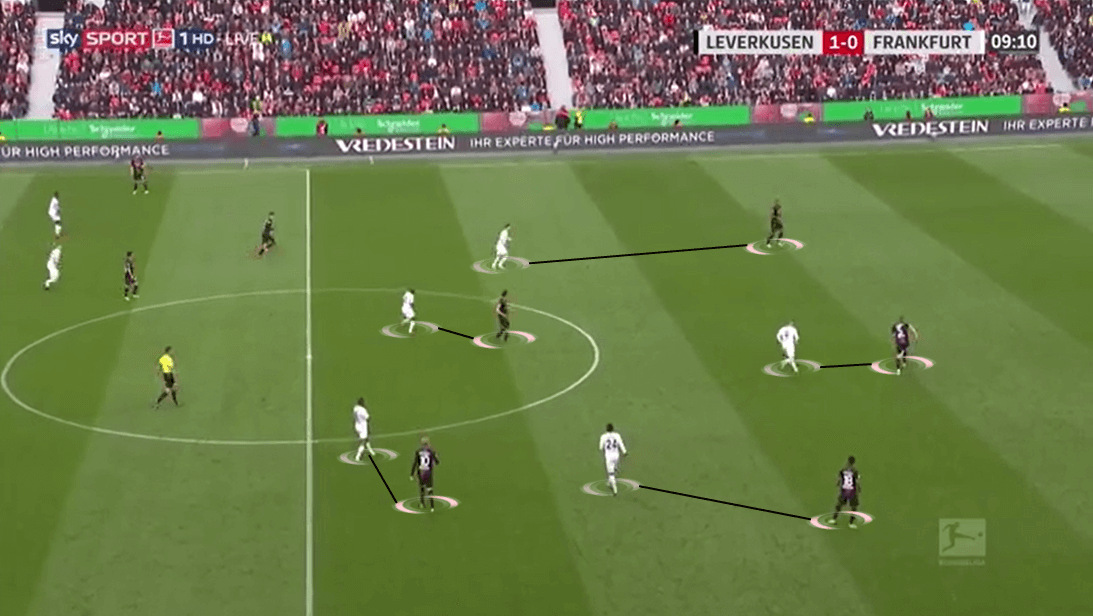
But they chose to press conservative rather than being aggressive. This allowed Leverkusen players to have more time executing their next move, making a pass or dribble their way out. In the shot below, we can see how Frankfurt prevented Leverkusen from building from the back. Each Leverkusen player was marked by one or even two Frankfurt players, except Wendell, the ball-carrier.
Even though they had more players in this situation, Leverkusen still managed to play out of the press. Da Costa and Willems had screened any passes that could come to Brandt, but the other two were left free. Wendell could either pass it to Aránguiz or Bender and these two would play long passes up front.
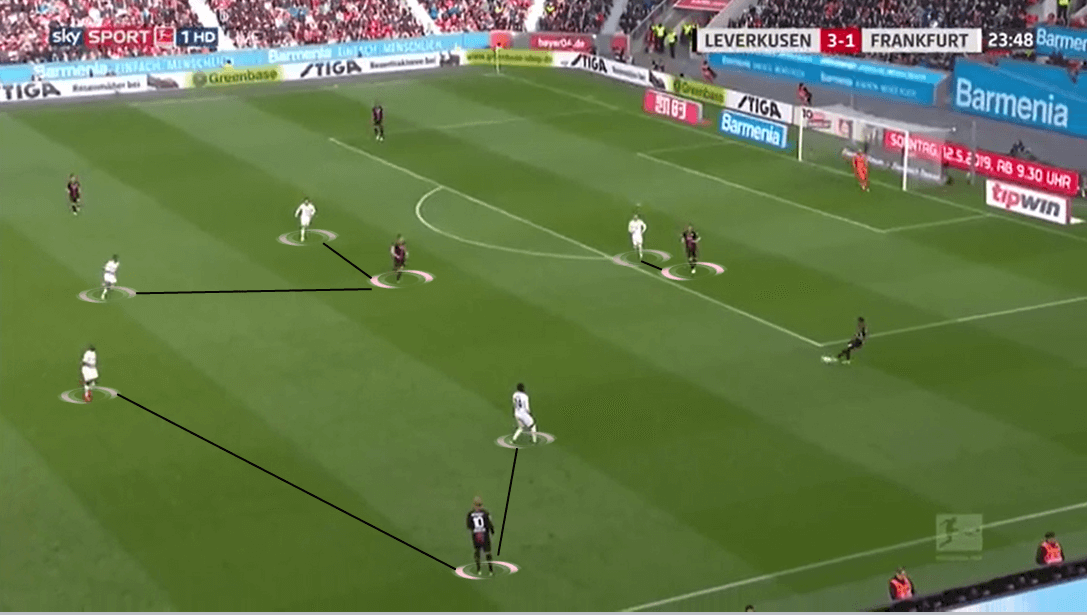
In the 37th minute, Hütter was forced to make two substitutions in the hope of a comeback. The Serbian duo Mijat Gácinović and Jović were subbed on for N’Dicka and Willems. He also changed the defensive structure into a 5-3-2.
The strikers up front would press the centre-backs and limit two passing options that the ball-carrier could have at the same time. Meanwhile, three central midfielders would shift across and with the aim to cut any through balls into their own half. This system had limited Leverkusen’s threat in some ways, but mainly because Leverkusen had lowered the tempo of their game.
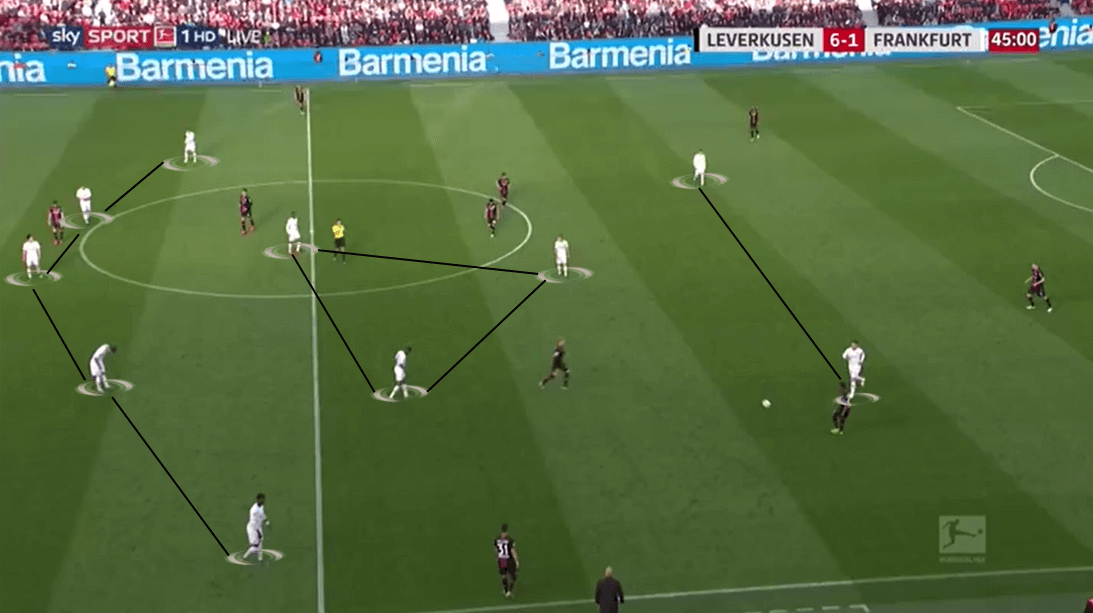
Conclusion
Leverkusen had treated their home fans with a goal-thrilling clash and kept three points safe at the BayArena. This helped them equalise their deficit with Frankfurt and retain their Champions League hope. Thanks to the chemistry of Brandt and Havertz, Bosz’s side managed to create and convert many chances. Keep this form going and we might soon witness the rise of a young and talented squad that Bosz has in his hand.
For Frankfurt, this thrashing loss might just be a wake-up call after their terrific form in both domestic and continental competitions. This game has once again shown Frankfurt’s heavy reliance on their attacking trio that consists of Jović, Rebić, and Haller. Without them, their force has clearly been reduced. Hütter needs to identify the problems and repair them before they travel to London for the semi-final away leg against Chelsea.
If you love tactical analysis, then you’ll love the digital magazines from totalfootballanalysis.com – a guaranteed 100+ pages of pure tactical analysis covering topics from the Premier League, Serie A, La Liga, Bundesliga and many, many more. Buy your copy of the April issue for just ₤4.99 here, or even better sign up for a ₤50 annual membership (12 monthly issues plus the annual review) right here.

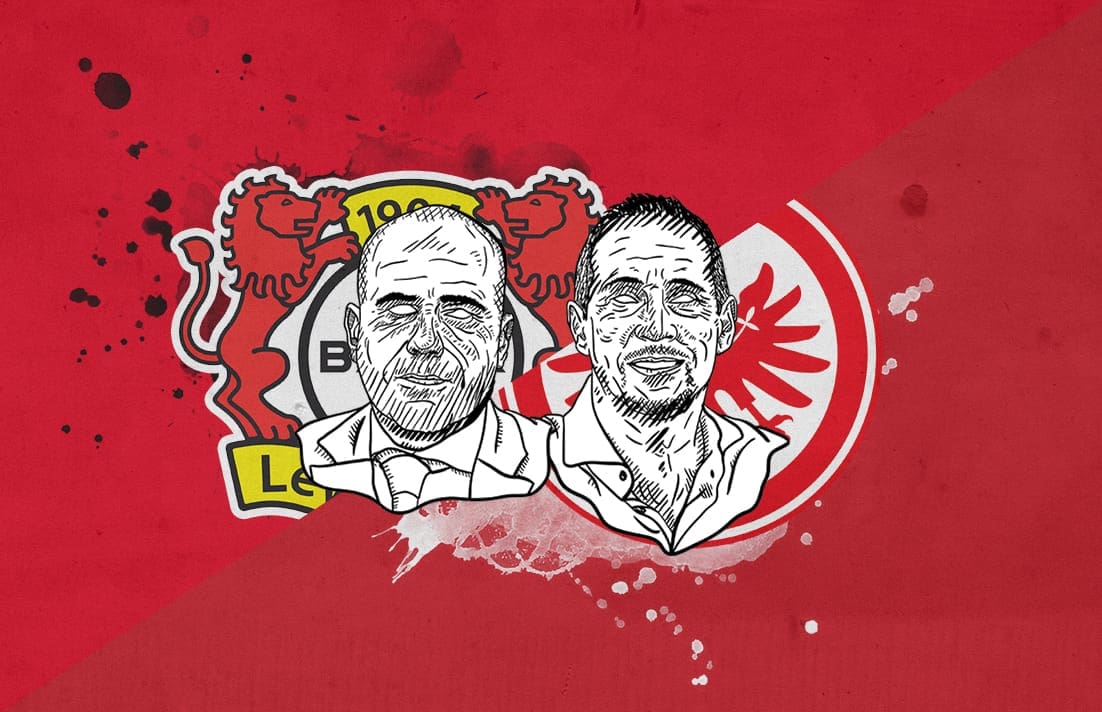



Comments